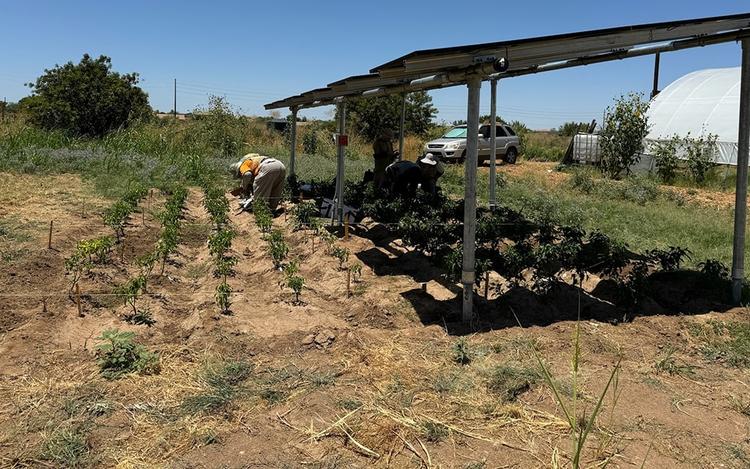( Cronkite News ) – WASHINGTON – For 31 straight days last summer, temperatures in Phoenix hit or topped 110 degrees, the longest such streak ever. That searing Arizona heat dehydrates crops and evaporates water the state needs to conserve.
Creating shade is one way to combat the problem.
By using solar panels, farmers can simultaneously protect their plants, save water and lower their energy bills – and some are doing just that with help from federal programs designed to encourage this sustainable method of growing.
Photovoltaic panels are placed above the crops, harnessing the sun’s energy while providing valuable shade.
“The solar arrays … will help shade and help reduce our water use and improve our water-use efficiency, which is very important in places like New Mexico and Arizona,” said Derek Whitelock, supervisory agricultural engineer at the U.S. Department of Agriculture. “Plants don’t need really as much sun as they get here in the West.”
Three-fourths of Arizona’s water supply goes to agricultural irrigation, according to the Arizona Department of Water Resources. The Colorado River Basin is in a Tier 1 water shortage, requiring restrictions for agricultural users. As drought continues, farmers are searching for new sustainable methods of growing.
The University of Arizona, in partnership with the U.S. Department of Agriculture, has created an agrivoltaics research site to study the ways that solar farming could benefit Arizona.
”You are getting significant water savings,” said Greg Barron-Gafford, the UArizona professor leading the effort.
A study led by Barron-Gafford found that when irrigating every other day on an agrivoltaic plot, soil moisture remained 15% higher than on a nearby plot without solar panels.
Some plants actually produced more with less water. Cowpea beans, for example – also known as black-eyed peas – had a higher crop yield when grown in the shade of solar panels. Full sun required twice as much water, it turned out.
“Agrivoltaics actually helped us get even more bean production because now we were providing the shade, so they were less stressed,” Barron-Gafford said.
The nonprofit organization Growing Green built an agrivoltaic plot on Spaces of Opportunity, a 19-acre community farm in Phoenix.

Farmers work underneath solar array on Spaces of Opportunity’s agrivoltaic plot in Phoenix. (Photo courtesy of Sarah Bendok)
Its small 4.8 kW system produces about 40% of the farm’s total energy needs, with a projected reduction of 17,000 lbs of carbon annually compared to conventional power generation, said Sarah Bendok, founder of Growing Green, and with more panels, “it can basically power everything on the farm. They have a cold storage where they put all of their produce that they want to store, the lights, the bathrooms, basically everything there.”
“It really feels great…to create a project that can benefit the community and the crops and the environment as a whole,” she said.
A number of federal programs are intended to promote sustainable growing methods, especially in tandem with renewable energy systems. The Rural Energy for America Program has sent $63 million to Arizona from 2018 to 2022.
REAP provides loans and grants to farmers who make clean energy investments. Funding comes from the Inflation Reduction Act, signed by President Joe Biden in August 2022, a major tax overhaul that included incentives for clean energy and climate mitigation.
Among numerous other provisions, the IRA offers farmers a 30% tax credit for incorporating solar panels.
The Gila River Indian Community began installing solar panels above the Casa Blanca Canal earlier this year, with $5.65 million in federal funding. Nearly 3,000 feet of the canal will be covered, conserving water by reducing evaporation – and generating over 1.31 megawatts of green energy, according to the U.S. Department of the Interior.
Via Cronkite News




 © 2025 All Rights Reserved
© 2025 All Rights Reserved